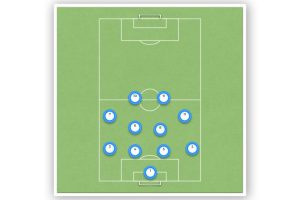Central vs Outside Pressing Traps
In modern soccer, defensive strategies are a cerebral mix of spatial control and psychological warfare. Pressing traps represent an intriguing facet of this, where teams induce opponents into dangerous areas to regain possession.
In this article, we’ll compare central and wide pressing traps.
Key Takeaways
- Central pressing traps maximize midfield density and can create immediate attacking opportunities.
- Outside pressing traps use the touchline as an ally, but require disciplined wide players.
- Implementing effective pressing traps depends on team strengths and adapting to the opponent’s tactics.
Understanding Pressing in Soccer
Pressing in soccer is an organized effort by a team to regain possession of the ball. This tactical approach leverages various pressing traps and formations to apply pressure on opponents, creating opportunities to force errors and gain advantage.
Pressing Fundamentals
At the core of pressing is a simple mandate: to constrain the opponent’s space and time on the ball.
Teams deploy pressing traps where they apply coordinated pressure to steer the play towards certain areas of the pitch.
High pressing involves forwards and midfielders working together just behind the defensive line, to restrict an opponent’s options and prompt a hasty decision, such as a misplaced pass or a bad touch.
When done right, it can render the opponent vulnerable and prone to errors.
Pressing Triggers
Pressing triggers are specific cues that signal a team to initiate their press.
A common trigger can be a misplaced pass, enabling the pressing team to close down the ball recipient before they can correct their mistake.
Other triggers include certain pitch locations—for example, when an opponent has the ball near the sidelines, it is an opportune moment for outside pressing traps, funneling the play into an area with limited escape routes.
Recognizing and responding to these triggers can significantly increase a team’s chances of recovering the ball.
Role of Formation in Pressing
The formation a team chooses heavily influences their pressing tactics.
A compact formation might focus on team pressing in the middle of the pitch, closing down spaces and corridors that opponents might use to progress the ball.
Conversely, a formation with wing-backs or wingers might favor wide pressing to exploit the sidelines.
Midfielders and forwards play pivotal roles here, and the tactical approach and pressing intensity must be adjusted in real-time as the game unfolds to maintain effectiveness.
Understanding whether to apply pressure through central pathways or from the flanks will depend on both the strengths of the pressing team and the weaknesses of their opponents.
Central Pressing Traps
In soccer, employing central pressing traps can decisively influence the game by creating turnovers and stifling the opposition’s play. This strategic approach focuses on exerting pressure in the central area of the pitch, leveraging the defensive line’s strength and compactness.

Benefits of Central Pressing
Central pressing traps shine by channeling play into the congested middle of the park, increasing the likelihood of winning back possession.
Tactically, teams using a central press can create a numerical advantage in key areas, intensifying pressure and potentially forcing mistakes from the opposition.
This tactic is often a cornerstone of gegenpressing, where teams immediately hunt for the ball post-turnover, exploiting any disarray within the opponent’s ranks.
- Foundational benefits include:
- Greater compactness in central areas
- High chance of turnovers leading to goal-scoring opportunities
- Disrupts the opposition’s planned routes of play
Implementing Central Pressing Traps
To effectively implement central pressing traps, coaches should focus on practice that enhances team communication and understanding of the tactic.
Players should be trained to recognize triggers for pressing, such as a poorly controlled ball or a backward pass by the opposition, to initiate the trap.
Defensive line coordination is paramount to shut down passing lanes, forcing the ball carrier into high-pressure zones.
- Key implementation strategies include:
- Regular training exercises that simulate game scenarios
- Drills to enhance player’s anticipation and reaction times
- Emphasizing the importance of team communication and compactness
Weaknesses of Central Pressing

While central pressing traps can be tremendously effective, they’re not without weaknesses.
Overcommitting resources in the central area can expose teams to wide play, where quick, skillful opponents might exploit the space on the flanks, potentially leading to vulnerability in wide defensive areas.
Furthermore, an unsuccessful central press can leave gaps in the midfield, which the opposition can exploit to advance forwards or even launch counter-attacks.
- Recognizable weaknesses consist of:
- Potential exposure to attacks from wide areas if the press is bypassed
- Risk of leaving gaps in the midfield on an unsuccessful press
Outside Pressing Traps
Outside pressing traps are a tactical approach focused on forcing the opposition into less threatening areas of the pitch such as the touchline. This technique applies pressure in the wider areas, with the intent to constrict the opponent’s play and regain possession.
Advantages of Outside Pressing
- Isolation of Opponents: By steering the play toward the touchline, defenders can isolate wingers or fullbacks, reducing their options for safe ball distribution.
- Reduced Options for Attack: Being near the touchline means the attacking team has one less angle to exploit, simplifying defensive responsibilities.
Executing Outside Pressing Traps
- Timely Engagements: Players must time their pressure swiftly as the opponent receives the ball, usually when there is a poor touch or when the ball is travelling to a player near the touchline.
- Cross-Coverage: Teammates should be prepared to provide cover, cutting off central passing lanes and ensuring that pressing is a coordinated team effort.
Limitations of Outside Pressing
- Vulnerability to Switches of Play: If the pressure is bypassed, there is a risk of leaving space open on the opposite side for a quick switch of play.
- Energy Intensive: This tactic requires significant stamina, as players need to cover large areas and engage in high-intensity pressing.
Comparative Analysis
In soccer, enforcing an effective pressing strategy often hinges on deciding whether to use central or outside pressing traps. Each approach leverages team strengths and targets opposition weaknesses.
Central vs Outside Pressing Strengths
- Central Pressing Traps:
- Strengths: Central pressing traps encourage compactness and often result in regaining possession in dangerous areas. By herding the opposition into the middle, teams can capitalize on numerical superiority and disrupt play at its creative heart.
- Implementing Tips: To ensure success with central pressing, formations like 4-3-3 or 4-2-3-1 are beneficial as they naturally congest the midfield.
- Outside Pressing Traps:
- Strengths: Pressing outside channels the opposition into areas where they are less dangerous, often near the sidelines where the play is more predictable and options are limited. This kind of pressure can force opponents into long, less accurate passes, making them more vulnerable to losing possession.
Central vs Outside Pressing Weaknesses
- Central Pressing Traps:
- Weaknesses: Overcommitting to central pressing can leave teams exposed to quick switches of play and vulnerable to counter-attacks down the flanks. If the press is bypassed, it can result in the opposition exploiting the space behind the press. Here, defenders may be in disadvantageous 1v1 situations against attackers.
- Mitigation Tips: Ensuring that the pressing trap is not overzealous requires training in trigger cues and spatial awareness. Teams should remain cognizant of their defensive structure even while pressing, ready to transition back if needed.
- Outside Pressing Traps:
- Weaknesses: When implementing outside pressing traps, there’s a risk that the opposition exploits the central area if the press is not coordinated or intense enough. Gaps can appear if players don’t maintain their defensive shape, leading to break-throughs in the heart of the defence.
- Mitigation Tips: Coordination is key for successful outside pressing. They must communicate and move as a unit to avoid creating gaps. Using touchlines as an additional defender can be effective, but it is vital to consistently track opposition movement and remain compact, particularly when the ball is central.
Practical Implementation Tips
Effective pressing traps in soccer defense require careful planning and practice. This section provides hands-on advice to coaches and players looking to master the intricacies of central and outside pressing.
Training Drills for Pressing
To instill a disciplined press, coaches should create drills that simulate real-match scenarios.
For central pressing, one useful drill is a high-pressure game where the central midfielders are tasked with forcing turnovers by making the pitch compact. The Soccer Coach Weekly site provides visual and tactical cues that these drills hinge upon.
As for outside pressing, wide-area trap drills challenge fullbacks and wingers to isolate opponents and regain possession along the touchlines. Here, they benefit from the additional ‘defender’ provided by the sideline.
- Drill #1: Central pressing 5v5 game in a reduced space.
- Drill #2: Outside pressing 3v3 game with touchline as the boundary.
In both drills, pressing intensity and coordinated movement are critical.
Communication and Coordination
A successful press is not just about physical intensity; communication is paramount. Players must continuously talk to each other to coordinate their movements and create pressing traps effectively.
Central defenders should direct traffic, ensuring the team maintains a cohesive shape, while wide players must communicate to decide when to shepherd opponents towards the line or cut off passing lanes inward.
- Call out when to engage in a press and when to hold formation.
- Alert teammates of oppressor changes and passing lane options.
Adjusting Tactics Mid-Game
Tactical flexibility is crucial for adapting to the evolving challenges of a match. A coach’s ability to perform tactical analysis can make or break a pressing strategy.
Sometimes, adjustments like changing the formation or pressing intensity are needed to reinforce a pressing trap or respond to the opponents’ adaptations. Continuous observation and quick decision-making are essential.
- Example: If the opponent bypasses the press, the coach might decide to drop deeper and focus on central solidity.
- Example: Against a team that plays wide, instructing players to force play inside can neutralize their advantage.
Frequently Asked Questions
In soccer defense, creating pressing traps is a tactic to regain possession of the ball. These traps can be set up either inside, closer to the opponent’s goal, or outside, near the sidelines.
What are the key differences between using inside pressing traps versus outside pressing traps in soccer defense?
Inside pressing traps are designed to force opponents into the central areas of the pitch where they can be outnumbered and more easily dispossessed. Using inside pressing traps, defenders and midfielders converge on the ball carrier, creating a compact space and reducing passing options.
In contrast, outside pressing traps push the play towards the touchlines. The sidelines act as an extra defender, limiting the space that an opponent has to operate within and making it easier to force mistakes or turnovers.
How can implementing inside traps strengthen a soccer team’s defensive strategy?
By employing inside traps, a team can congest play in the center and increase the likelihood of intercepting passes. It creates opportunities for quick transitions to attack, as winning the ball in central areas often leaves the opposing defense unorganized. Effective inside traps require excellent teamwork and communication to ensure gaps are covered.
In what situations are outside pressing traps preferred in soccer, and why?
Outside traps are typically used near the sidelines when the opposing team’s player receiving the ball is isolated and has limited support. It allows the defending team to surround the player, blocking inward passes and forcing them to play the ball down the line or concede possession.
What are the potential pitfalls of employing inside traps during a soccer match?
The primary risk of inside traps is that if an opposing player manages to bypass the press, it can leave the defense exposed and vulnerable to counter-attacks. Additionally, it requires a high level of stamina and coordination; if not executed correctly, it can result in a disjointed team shape and open spaces for opponents to exploit.
Can you provide tips on effectively setting up outside pressing traps in soccer?
To set up effective outside traps, defenders should funnel attackers towards the flanks, using angled runs to cut off passing lanes. Players need to communicate and work as a cohesive unit to make sure that pressing players are supported, preventing the ball from being played inside.
How do inside and outside pressing traps impact the overall team shape and defensive solidity in soccer?
Inside and outside pressing traps influence team shape by dictating where on the pitch the ball is confronted.
Inside traps can compress a team centrally, potentially making it solid against central threats, but possibly more vulnerable on the flanks.
Conversely, outside traps can stretch a team laterally and may solidify wing defense yet leave central areas less guarded if not balanced properly.
Strategic application of both methods is critical for maintaining overall defensive solidity.








